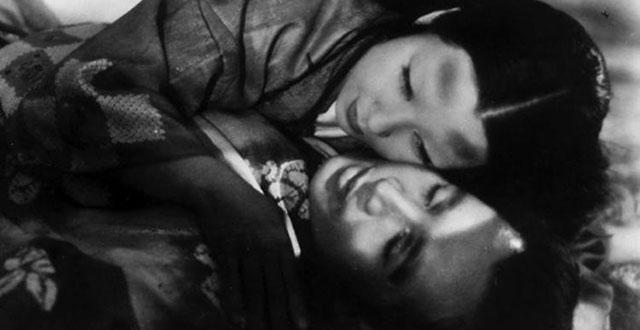
Out of the Vaults: "Ugetsu", 1953
Meher Tatna 08/04/2020Hailed by critics as one of the world’s greatest filmmakers, Kenji Mizoguchi started his career making silent films in the 1920s with remakes and adaptations of classic writers like Tolstoy and O’Neill. In the 1930’s he moved on to films that commented on the social upheavals that Japan was going through at the time. Transitioning from propaganda films in the war years of the 1940s like The 47 Ronin to period dramas focusing on women’s issues such as suffrage (Victory of the Women (1946) and My Love Has Been Burning (1949)), he was a feminist filmmaker ahead of his time. Through the years, Mizoguchi honed the poetic visual style that revealed his ‘tragic humanism,’ shown to best effect in his later period films, particularly in his masterwork Ugetsu Monogatari which was his 78th film.
Most of Mizoguchi’s oeuvre, which totals 90 overall, were silent films that are lost. A particular favorite of director Martin Scorsese, Ugetsu was restored in digital 4K through his The Film Foundation and the Kadokawa Corporation at Cineric Laboratories in New York, with funding from the Hollywood Foreign Press Association.
At a 2016 presentation of the restored film by the HFPA in Bologna at Il Cinema Ritrovato, Scorsese sent a video message in which he said: “I first saw Ugetsu on TV in 1958 and I have been obsessed ever since by its beauty and poetry. It was very hard to find the various elements to restore and save this masterpiece and I have to thank our friends of the Hollywood Foreign Press for making it happen.”
The restoration process used the master positive and dupe negative which were determined to be the best elements available. The film was scanned at Cineric and picture restoration and grading were supervised by Scorsese and Masahiro Miyajima, who had worked with cinematographer Kazuo Miyagawa for over 30 years. Audio mechanics performed the digital restoration of the soundtrack from the master positive. An internegative of the picture restoration and an optical soundtrack negative have been created for preservation, as well as 35mm film prints and DCPs for exhibition. The restoration was premiered at the 2016 Cannes Film Festival as part of Cannes Classics.
Ugetsu is based on two short stories, The House in the Thicket and The Lust of the White Serpent from Akirari Ueda’s 18th century Tales of Moonlight and Rain. Interwoven is Guy de Maupassant’s story Décoré!.
Mizoguchi instructed his two screenwriters Matsutaro Kawaguchi and Yoshikata Yoda thus: “The feeling of wartime must be apparent in the attitude of every character. The violence of war unleashed by those in power on a pretext of the national good must overwhelm the common people with suffering—moral and physical. Yet the commoners, even under these conditions, must continue to live and eat. This theme is what I especially want to emphasize here. How should I do it?”
In the civil war of 16th century Japan, a potter and his brother leave their families behind in order to profit from wartime demand for the potter’s wares in a neighboring village. Genjuro, the potter, played by Masayuki Mori, is hungry for wealth; Tobei (Eitaro Ozawa) wants glory as a samurai. Genjuro is seduced by a beautiful ghost, Lady Wakasa (Machiko Kyo), and Tobei endures much humiliation before he becomes a samurai by chance. Mizoguchi shows the suffering of the peasantry in wartime particularly through the plight of the wives as the men are blinded in the pursuit of their grandiose dreams.
The director has a signature “flowing scroll” of long, uninterrupted takes. He shoots mostly master shots, a majority with cranes. There are very few closeups. The title scenes are that of a medieval scroll reminiscent of a kimono. As his camera moves, he manages to straddle the real and the supernatural with ease, particularly in the famous lake scene where a mysterious man warns the protagonists of pirates before he dies. A keening soundtrack accompanies the mists and fog surrounding the boat on which the terrified peasants are huddled. Cinematographer Kazuo Miyagawa worked with Mizoguchi six times, including his last film, Street of Shame (1956). He later remarked that Ugetsu was the only film for which his work was praised by the master.
Mizoguchi was a perfectionist, often doing hundreds of retakes before he was satisfied and constantly asking for rewrites in the middle of shooting. He was also uncompromising on historical detail like the costumes, props, and suits of armor for the soldiers.
Fans of Mizoguchi's later films were mostly in the West as local audiences in Japan at the time did not have much interest in his work. Jean-Luc Godard declared him “the greatest of Japanese filmmakers, or quite simply one of the greatest of filmmakers.” He won the Silver Lion for best director in 1953 at the Venice Film Festival for Ugetsu, in competition with William Wyler’s Roman Holiday. In Keiko McDonald’s book Mizoguchi, she writes that it was his first trip outside Japan and he spent most of his time in his hotel room praying to a scroll, worrying about how he could return to Japan if he did not win. The film was also Oscar-nominated for best costume design in 1956. It was included in Sight and Sound magazine’s once-a-decade poll as one of the greatest films ever made in 1962 and 1972, and has a 100% positive rating on Rotten Tomatoes.
Kenji Mizoguchi died of leukemia three years after the release of Ugetsu.
HFPA